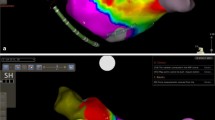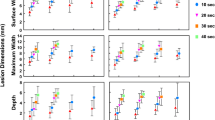Abstract
The Cox-Maze procedure and less complex modifications have gained widespread use as a treatment modality for patients with concomitant atrial fibrillation. Hypothermic or hyperthermic energy sources play a significant role in rapidly creating linear lesions. Endocardial ablation is easy to perform and effective with different energy sources. Epicardial techniques may simplify the procedure by allowing surgery on a beating heart. But epicardial fat and the heat sink effect of the flowing endocardial blood are obstacles to effective ablation. New devices using bipolar (irrigated) radiofrequency, microwave or laser energy, cryoablation or focused ultrasound are in clinical or pre-clinical stages and permit lesions to be created on a beating heart without cardiopulmonary bypass. Minimally invasive or video-assisted surgical techniques and effective devices for epicardial ablation will enable the treatment of patients suffering from lone atrial fibrillation. To facilitate the comparison between different techniques and devices, guidelines for reporting clinical results are necessary.
Zusammenfassung
Die Cox-Maze-Operation und ihre chirurgisch weniger komplexen Modifikationen sind heute zur Behandlung des Vorhofflimmerns begleitend zu anderen herzchirurgischen Eingriffen weitgehend anerkannt. Durch eine Ablation des Vorhofmyokards mit Kälte oder Hitze können rasch lineare Läsionen erzeugt werden. Das endokardiale Vorgehen unter Verwendung unterschiedlicher Energiequellen hat sich als technisch einfach und effektiv erwiesen. Mit epikardialen Techniken kann die Prozedur weiter vereinfacht und am schlagenden Herzen durchgeführt werden. Hindernisse für die Gewährleistung transmuraler Linien sind das epikardiale Fettgewebe und der kühlende oder erwärmende Effekt des subendokardialen Blutflusses. Neue Sondentechnologien unter Verwendung von bipolarer (gekühlter) Radiofrequenz-, Mikrowellen- oder Laserenergie, Cryoablation oder fokusiertem Ultraschall sind derzeit in vor- oder klinischer Erprobung. Damit sollten auch am schlagenden Herzen ohne Einsatz der Herzlungenmaschine transmurale Läsionen realisierbar sein. Mit diesen neuen Technologien und einem minimalinvasiven oder endoskopischen chirurgischen Vorgehen kann auch für Patienten mit „lone atrial fibrillation“ eine alternative Therapieform angeboten werden. Zur besseren Erfassung und zum wissenschaftlichen Vergleich der unterschiedlichen Techniken sind Empfehlungen zur einheitlichen Sammlung und Auswertung klinischer Daten notwendig.
Similar content being viewed by others
Literatur
Accord RE, van SuylenRJ, van Brakel TJ, Maessen JG (2005) Post-mortem histologic evaluation of microwave lesions after epicardial pulmonary vein isolation for atrial fibrillation. Ann Thorac Surg 80:881–887
Climent V, Hurlé A, Ho SY et al (20049 Early morphologic changes following microwave endocardial ablation for treatment of chronic atrial fibrillation during mitral valve surgery. J Cardiovasc Electrophysiol 15:1277–1283
Cox JL (2003) Atrial fibrillation II: Rationale for surgical treatment. J Thorac Cardiovasc Surg 126:1693–1699
Doll N, Kiaii BB, Fabricius AM et al (2003) Intraoperative left atrial ablation (for atrial fibrillation) using a new Argon cryocatheter: Early clinical experience. Ann Thorac Surg 76:1711–1715
Gillinov M, Pettersson G, Cosgrove III DM (2005) Stapled excision of the left atrial appendage. J Thorac Cardiovasc Surg 129:679–680
Haïssaguerre M, Jaïs P, Dipen CS et al (1998) Spontaneous initiatation of atrial fibrillation by ectopic beats originating in the pulmonary veins. New Engl J Med 339:659–666
Khargi K, Hutten BA, Lemke B, Deneke T (2004) Surgical treatment of atrial fibrillation; a systematic review. Europ J Cardio-thorac Surg 27:258–265
Lall SC, Melby SJ, Voeller RK et al (2007) The effect of ablation technology on surgical outcomes after the Cox-maze procedure: a propensity analysis. J Thorac Cardiovasc Surg 133:389–396
Marui A, Nishina T, Tambara K et al (2006) A novel atrial volume reduction technique to enhance the Cox maze procedure: initial results. J Thorac Cardiovasc Surg 132:1047–1053
Mehall JR, Kohut RM Jr, Schneeberger EW et al (2007) Intraoperative epicardial electrophysiologic mapping and isolation of autonomic ganglionic plexi. Ann Thorac Surg 83:538–541
Melby SJ, Gaynor SL, Lubahn JG et al (2006) Efficacy and safety of right and left atrial ablations on the beating heart with irrigated bipolar radiofrequency energy: a long-term animal study. J Thorac Cardiovasc Surg 132:853–860
Mokadam NA, McCarthy PM, Gillinov AM et al (2004) A prospective multicenter trial of bipolar radiofrequency ablation for atrial fibrillation: Early results. Ann Thorac Surg 78:1665–1670
Ninet J, Roques X, Seitelberger R et al (2005) Surgical ablation of atrial fibrillation with off-pump, epicardial, high-intensity focused ultrasound: Results of a multicenter trial. J Thorac Cardiovasc Surg 130:803.e1–803.e8
Pappone C, Santinelli V, Manguso F et al (2004) Pulmonary vein denervation enhances long-term benefit after circumferential ablation for paroxysmal atrial fibrillation. Circulation 109:327–334
Prasad SM, Maniar HS, Diodato MD et al (2003) Physiological consequences of bipolar radiofrequency energy on the atria and pulmonary veins: A chronic animal study. Ann Thorac Surg 76:836–842
Salenger R, Lahey SJ, Saltman AE (2004) The completely endoscopic treatment of atrial fibrillation: Report on the first 14 patients with early results. Heart Surg Forum 7:E554–558
Santiago T, Melo J, Gouveia RH et al (2003) Epicardial radiofrequency applications: in vitro and in vivo studies on human atrial myocardium. Europ J Cardio-thorac Surg 24:481–486
Schauerte P, Scherlag BJ, Pitha J et al (2000) Catheter ablation of cardiac autonomic nerves for prevention of vagal atrial fibrillation. Circulation 102:2774–2780
Shemin RJ, Cox JL, Gillinov AM et al (2007) Guidelines for reporting data and outcomes for the surgical treatment of atrial fibrillation. Ann Thorac Surg 83:1225–1230
Starck C, Botha CA, Roser D et al (2003) Results of a modified left atrial maze procedure as a combined procedure. Thorac Cardiovasc Surg, 51:147–153
Sueda T, Nagata H, Shikata H et al (1996) Simple left atrial procedure for chronic atrial fibrillation associated with mitral valve disease. Ann Thorac Surg 62:1796–1800
Stöllberger C, Schneider B, Finsterer J (2003) Elimination of the atrial appendage to prevent stroke or embolism? Chest 124:2356–2362
Stulak JM, Dearani JA, Sundt TM 3rd et al (2007) Superiority of cut-andsew technique fort he Cox maze procedure: Comparison with radiofrequency ablation. J Thorac Cardiovasc Surg 133:1022–1027
Thomas SP, Guy DJR, Boyd AC et al (2003) Comparison of epicardial and endocardial linear ablation using handheld probes. Ann Thorac Surg 75:543–548
Todd DM, Skanes AC, Guiraudon G et al (2003) Role of the posterior left atrium and pulmonary veins in human lone atrial fibrillation. Circulation 108:3108–3114
Van Brakel TJ, Bolotin G, Salleng KJ (2004) Evaluation of epicardial microwave ablation lesions: Histology versus electrphysiology. Ann Thorac Surg 78:1397–1402
Vigilance DW, Garrido M, Williams M et al (2006) Off-pump epicardial atrial fibrillation surgery utilizing a novel bipolar radiofrequency system. Heart Surg Forum 9:E803–806
Williams MR, Casher JM, Russo MJ et al (2006) Laser energy source in surgical atrial fibrillation ablation: preclinical experience. Ann Thorac Surg 82:2260–2264
Williams MR, Garrido M, Oz MC, Argenziano M (2004) Alternative energy sources for surgical atrialablation. J Card Surg 19:201–206
Wolf RK, Schneeberger W, Osterday R et al (2005) Video-assisted bilateral pulmonary vein isolation and left atrial appendage exclusion for atrial fibrillation. J Thorac Cardiovasc Surg 130:797–802
Author information
Authors and Affiliations
Corresponding author
Rights and permissions
About this article
Cite this article
Hemmer, W., Böhm, J.O. Zukunftsvisionen und neue Technologien in der chirurgischen Behandlung des Vorhofflimmerns. Herzschr. Elektrophys. 18, 92–100 (2007). https://doi.org/10.1007/s00399-007-0560-2
Received:
Accepted:
Issue Date:
DOI: https://doi.org/10.1007/s00399-007-0560-2




